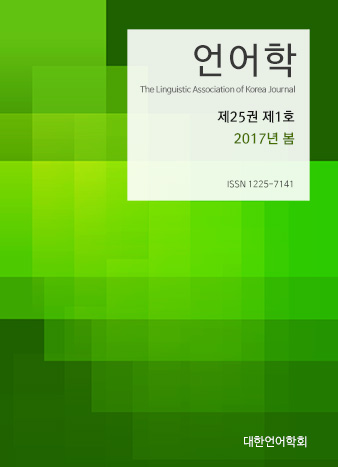대한언어학회 전자저널

-
Why is the Locative NP in Kiswahili not Syntactically Oblique?
-
Developmental Errors in Chinese L1 Speakers’ Use of the L2 English Past Tense and Perfective Aspect
-
An Exploration of High School Reading Test Items Based on Discriminant Analysis
-
Marketization of University Brochures in Korea and the US: From a Genre Analysis Perspective
25권 1호 (2017년 3월)
- An Exploration of High School Reading Test Items Based on Discriminant Analysis
-
Nayu Kim & Heechul Lee
Pages : 75-92
Abstract
Keywords
# high school English reading test items # discriminant analysis # types of item
References
- Ackerman, T., & Shu, Z. (2009). Using confirmatory MIRT modeling to provide diagnostic information in large scale assessment. Paper presented at the annual meeting of the National Council of Measurement in Education, San Diego, CA.
- Bachman, L. F. (1998). Language testing-SLA research interfaces. In L. F. Bachman & A. D. Cohen (Eds.), Interfaces between second language acquisition and language testing research (pp. 177-195). Cambridge: Cambridge University Press .
- Block, E. (1986). The comprehension strategies of second language learners. TESOL Quarterly, 20, 463-494.
- Bock, R. D., Gibbons, R., & Muraki, E. (1988). Full-information item factor analysis. Applied Psychological Measurement, 12, 261-80.
- Carrell, P. L. (1983). Three components of background knowledge in reading comprehension. Language Learning, 33(2), 183-207.
- Choi, K.-H., & Lee, J.-H. (2010). Devising of proper items for the evaluation of English proficiency test: A case study in J university. Modern Studies in English Language & Literature, 54(3), 171-186.
- von Davier, M. (2008) A general diagnostic model applied to language testing data. British Journal of Mathematical and Statistical Psychology, 61, 287-307.
- van Dijk, T., & Kintsch, W. (1978). Towards a model of text comprehension and production. Psychological Review, 85, 363-394.
- Gibbons, R. D., & Hedeker, D. R. (1992). Full-information item bi-factor analysis. Psychomerika, 57, 423-36.
- Grabe, W. (2001). Reading-writing relations: Theoretical perspectives and instructional practices. In D. Lcher & A. Hirvelam (Eds.), Linking literacies: Perspectives on L2 reading-writing connections (pp. 15-47). Ann Arbor, MI: Michigan University Press.
- Haladyna, T. M., & Kramer, G. A. (2004). The validity of subscores for a credentialing test. Evaluation and the Health Professions, 27(4), 349-68.
- Han, Mihyang. (2007). EFL readers' test-taking processes for completion vs. multiple choice cloze tests. The Linguistic Association of Korea Journal, 15(3), 189-208.
- Hanson, B. A., & Harris, D. J. (1991). Methods of examining the usefulness of subscores. Paper presented at the meeting of the National Council on Measurement in Education, Chicago, IL.
- Hays, R. D., Morizot, J., & Reise, S. P. (2007). The role of the bifactor model in resolving dimensionality issues in health outcomes measures. Quality of Life Research, 16, 19-31.
- Hong, Y., Song, H., & de la Torre, J. (2011). A comparison of four methods of IRT subscoring. Applied Psychological Measurement, 35(4), 296-316.
- Kitao, S. K., & Kitao, K (1997). Validity and reliability, in TESL-L Electric Discussion Forum.
- Koo, M., & Yang, K. (2013). Discriminant Analysis of Korean Reading Text Difficulty. Bilingual Research, 52, 1-18.
- Lane, S., Stone, C. A., Ye, F., & Zhu, X. (2010). Providing subscale scores for diagnostic information: A case study when the test is essentially unidimensional. Applied Measurement in Education, 23, 63-86.
- Ling, G. (2009). Why the major field test does not report subscores of individual test-takers —Reliability and construct validity evidence. Paper presented at the annual meeting of American Educational Research Association and the National Council on Measurement in Education.
- Rumelhart, D. E. (1980). Schemata: The building blocks of cognition. In R. J. Spiro, B. C. Bruce & W. E. Brewer (Eds.), Theoretical issues in reading comprehension (pp. 33-58). Hillsdale, NJ: Lawrence Erlbaum.
- Spolsky, B. (1990). Social aspects of individual assessment. In J. H. A. de Jong & D. K. Stevenson. Individualizing the assessment of language abilities. Clevdon, Avon, England: Multilingual Matters Ltd.
- Storey, P. (1997). Examining the test-taking process: A cognitive perspective on the discourse cloze test. Language Testing, 14(2), 214-231.
- Stout, W. (1987). A non-parametric approach for assessing latent trait unidimensionality. Psycholmetrika, 52, 589-617.
- Stout, W., & Zhang, J. (1999). The theoretical DETECT index of dimensionality and its application to approximate simple structure. Psychometrika, 64, 213-49.
- Wainer, H, Vevea, J. L., Camacho, R., Reeve, B. B., Swygart, K. A., & Thissen, D. (2001). Augmented scores-borrowing strength to compute scores based on small numbers of items. In D. Thissen & H. Wainer (Eds), Test Scoring. Mahwah, NJ: Lawrence Erlbaum.
- Yamashita, J. (2003). Processes of taking a gap-filling test: Comparison of skilled and less skilled EFL readers. Language Testing, 20(3), 267-293.